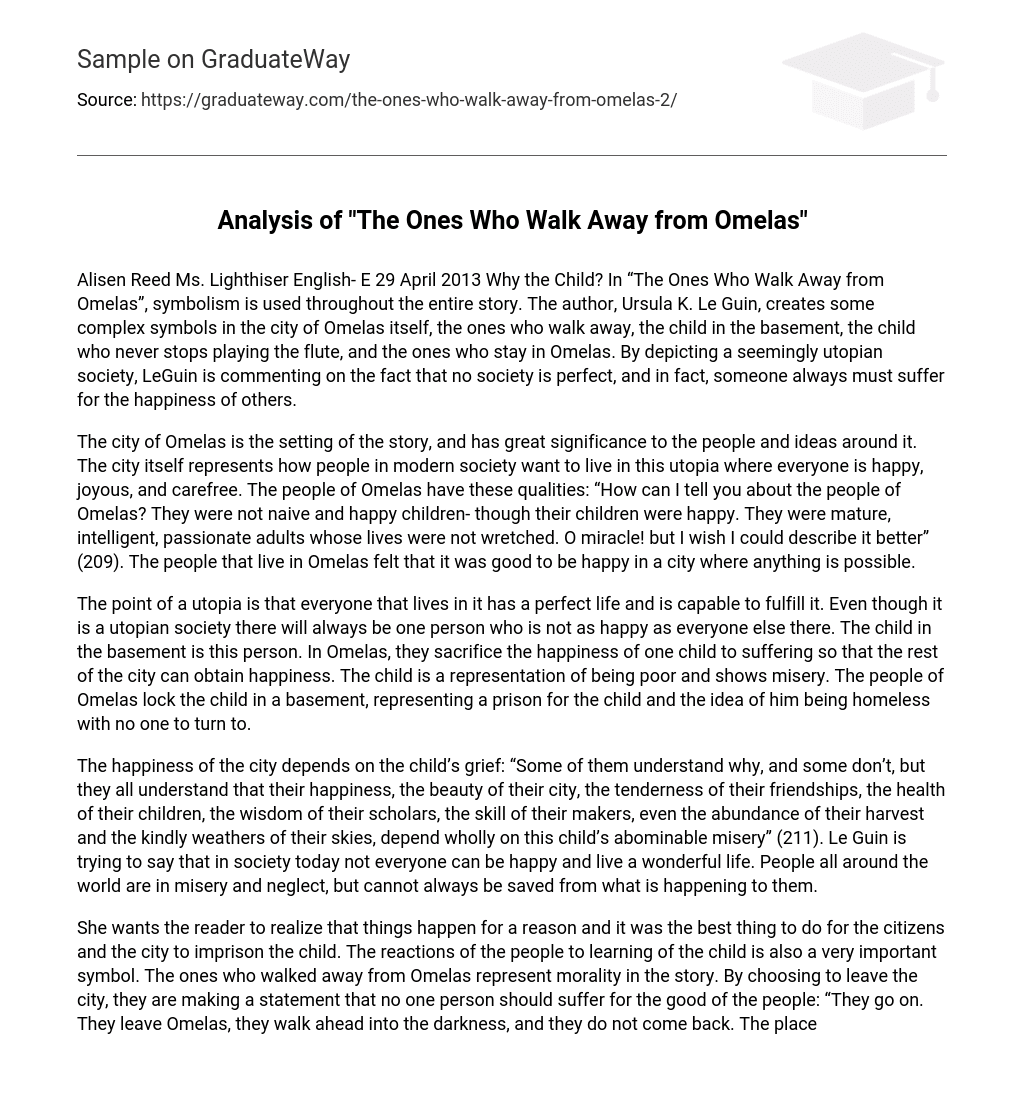In “The Ones Who Walk Away from Omelas” by Ursula K. Le Guin, symbolism is utilized. Le Guin incorporates multiple intricate symbols, including the city of Omelas, the people who opt to leave, the captive child, the flutist playing nonstop, and the residents who stay in Omelas. By depicting a seemingly perfect society, Le Guin communicates that no society can attain flawlessness unless someone sacrifices their own welfare for the overall bliss of others.
The story is set in the city of Omelas, which holds great significance to its inhabitants and their beliefs. Omelas symbolizes society’s yearning for a perfect world where everyone lives happily and without worries. The people of Omelas possess certain qualities: “How can I describe to you the nature of the people in Omelas? They were not naive and joyful children, although their own children were indeed happy. They were mature, intelligent, and passionate adults who did not lead miserable lives. Oh, what a miracle! I only wish I could depict it better” (209). The residents of Omelas believed that living in a city where anything is possible meant experiencing genuine happiness.
The idea of a utopia encompasses the notion of all individuals leading impeccable lives and having the resources to achieve contentment. Nevertheless, even in an ideal society, there will perpetually exist one person who does not experience equivalent happiness as others. This particular individual is symbolized by the child confined in the basement within Omelas. For the remainder of the city’s inhabitants to attain joy, they must sacrifice this child’s suffering. This child represents poverty and exhibits profound anguish. The people of Omelas confine this child in a basement, which serves as both a metaphorical prison and reflects their homelessness and absence of support.
According to Le Guin, the child’s grief is crucial for the happiness and well-being of the city. While some individuals comprehend the reasons behind this sorrow, others do not. Nevertheless, they all recognize that various aspects of their lives, such as the beauty of their city, the warmth of their friendships, the health of their children, the wisdom of their scholars, the talent of their creators, the abundance of their harvest, and the favorable weather, rely entirely on this child’s dreadful misery (211). Le Guin’s message is that in today’s society, not everyone can experience happiness and lead a splendid existence. Numerous individuals worldwide suffer from misery and neglect, yet they cannot always be rescued from these circumstances.
The author’s intention is for the reader to acknowledge that there is a purpose to events and that imprisoning the child was the optimal decision for both the citizens and the city. The response of the individuals upon discovering the child holds significant symbolic value. Those who departed from Omelas serve as a representation of morality in the narrative. By opting to abandon the city, they are asserting that no individual should endure suffering for the greater good: “They go on. They leave Omelas, they walk ahead into the darkness, and they do not come back. The place they go towards is a place even less imaginable to most of us than the city of happiness.”
Le Guin suggests the notion that a “perfect society” does not exist by portraying the actions of those who depart from Omelas. The individuals who choose to leave are seemingly migrating towards a society that lacks the same level of perfection and bliss. Although not a utopia, it represents a more practical place to reside. In contrast, there are those who opt to remain, symbolizing selfishness.
They lack concern for the suffering of one individual in order to maintain their collective happiness. Ideally, they would prioritize the wellbeing of every resident in their utopian society. While the people value the freedom of children, freeing the child would dismantle the perfection of the utopia. If the child were rescued from its abominable conditions, nurtured, and provided for, that would be a truly positive outcome. However, such an act would result in the downfall and demise of Omelas’ prosperity, beauty, and joy (211).
This text emphasizes the significance of realism in understanding human behavior. It portrays a character who is both selfish and slightly sympathetic towards someone who has been mistreated. Le Guin aims to convey that individuals vary in their treatment of others. The symbolism employed in this story offers a powerful reflection of contemporary society. It reminds us that not all societies can be considered utopias, as there are always flaws in how citizens interact and envision the ideal society.





